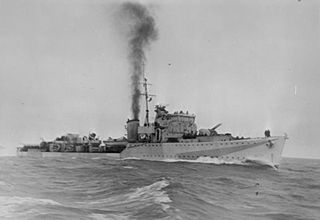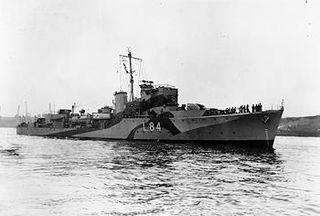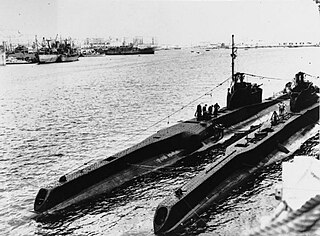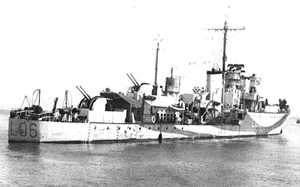
HMS Quorn was a Hunt-class destroyer of the Royal Navy, built in 1940 and sunk off the Normandy coast on 3 August 1944. The class were named after British fox and stag hunts, in this case, the Quorn Hunt, predominantly based in Leicestershire.

ORP Burza was a Wicher-class destroyer of the Polish Navy which saw action in World War II.

HMS Hursley was a Second World War Type II Hunt-class escort destroyer of the British Royal Navy. She is the only Royal Navy ship to have carried this name. Hursley is a village in Hampshire. Commissioned in 1942, she served in the Mediterranean, before being transferred to the Hellenic Navy in November 1943 and renamed Kriti. She took part in the landings in Sicily, Anzio, and southern France, and remained in Greek service until 1959.

Adrias was a Type III Hunt-class destroyer that was originally built for the Royal Navy as HMS Border but never commissioned. Before her completion, she was loaned to the Royal Hellenic Navy on 20 July 1942 and commissioned as Adrias on 5 August 1942 in order to relieve heavy losses of ships sustained by the Royal Hellenic Navy during the German invasion of 1941 and throughout the war. Adrias took her name from the ancient Greek town of Adria in Italy, at the mouth of the Po river, after which the Adriatic Sea is named.

HMS Turbulent (N98) was a T-class submarine of the Royal Navy. It was laid down by Vickers Armstrong, Barrow and launched in May 1941.

HMS Beaufort was a Hunt-class destroyer of the Royal Navy. She was laid down on 17 July 1940 at Cammell Laird, Birkenhead. She was launched on 9 June 1941 and commissioned on 3 November 1941. During the Second World War the ship served in the Mediterranean Sea, escorting convoys and covering landings. She was transferred to the Royal Norwegian Navy in 1952 and scrapped in 1965.

Vice-Admiral Sir Arthur Richard Hezlet, nicknamed Baldy Hezlet, was a decorated Royal Navy submariner. He became the Royal Navy's youngest captain at the time – aged 36 – and its youngest admiral, aged 45. In retirement he became a military historian.
HMS Marigold was a Flower-class corvette of the Royal Navy. She was launched on 4 September 1940 and was sunk by an Italian air-dropped torpedo on 9 December 1942.

HMS Penylan was a Hunt-class destroyer of the Royal Navy. She was a member of the third subgroup of the class, and saw service in the Second World War, before being sunk by German E-boats in 1942.

HMS Tetcott was a Type II British Hunt-class destroyer built for the Royal Navy during World War II. She was the only Royal Navy ship to be named after the Tetcott fox hunt.

HMS Avon Vale(pennant number L06) was an escort destroyer of the Hunt Type II class. The Royal Navy ordered Avon Vale's construction three days after the outbreak of the Second World War. John Brown Shipbuilding & Engineering Company Ltd laid down her keel at their Clydebank yard on 12 February 1940, as Admiralty Job Number J1569. After a successful Warship Week national savings campaign in February 1942, Avon Vale was adopted by the civil community of Trowbridge, Wiltshire.

HMS Tynedale was a Hunt-class destroyer of the first subgroup which served during the Second World War. She was sunk by the U-593 on 12 December 1943.

HMS Blankney was a Hunt-class destroyer of the Royal Navy and was the first and so far only warship to bear the name. She was laid down on 17 May 1940 at John Brown & Company, Clydebank, Scotland, launched on 19 December 1940 and commissioned on 11 April 1941.

HMS Ekins (K552) was a British Captain-class frigate of the Royal Navy that served during World War II. Originally constructed as a United States Navy Buckley class destroyer escort, she served in the Royal Navy from 1943 to 1945.

HMS Aldenham was an escort destroyer of the Type III Hunt class. The Royal Navy ordered its construction in July 1940. Upon completion in February 1942, she was deployed to convoy escort duty. Aldenham is one of the ships credited with the sinking of the U-587 on 27 March 1942. After circumnavigating Africa, she joined the Mediterranean Fleet, escorting convoys between Alexandria, Malta and Tobruk. She took part in the Allied invasion of Sicily, landings at Salerno and Anzio, the Dodecanese campaign and Operation Dragoon before being assigned to the Adriatic campaign.

The second HMS Wivern, was a Modified W-class destroyer of the British Royal Navy that saw service in World War II.

HMS Pakenham (G06) was a P-class destroyer of the British Royal Navy built and operated during World War II. Commissioned in early 1942, she took part in the invasion of Madagascar, and several Malta Convoys, before being disabled in a battle with Italian torpedo boats in April 1943 and scuttled.

HMS Berkeley was a Type I Hunt-class destroyer of the Royal Navy. She was a member of the first subgroup of the Hunt class and saw service in World War II before being bombed at Dieppe and then scuttled by HMS Albrighton.
HMS Heythrop (L85) was a Hunt-class destroyer of the Royal Navy She was ordered as part of the 1939 War Emergency programme. She was launched in 1940 and served during the Second World War. She was named after the Heythrop Hunt.

HMS Puckeridge was a Hunt-class destroyer of the Royal Navy and first and so far only warship to bear the Name. The vessel was ordered on 4 September 1939 as part of the 1939 wartime emergency program. She was laid down on 1 January 1940 at the J. Samuel White yard, East Cowes, on the Isle of Wight, launched on 6 March 1941 and commissioned on 30 July 1941.



















